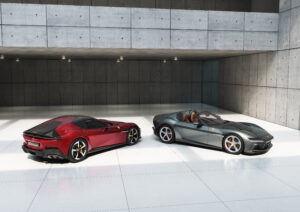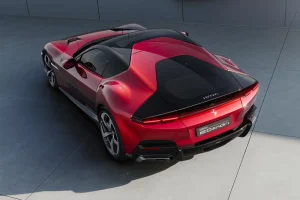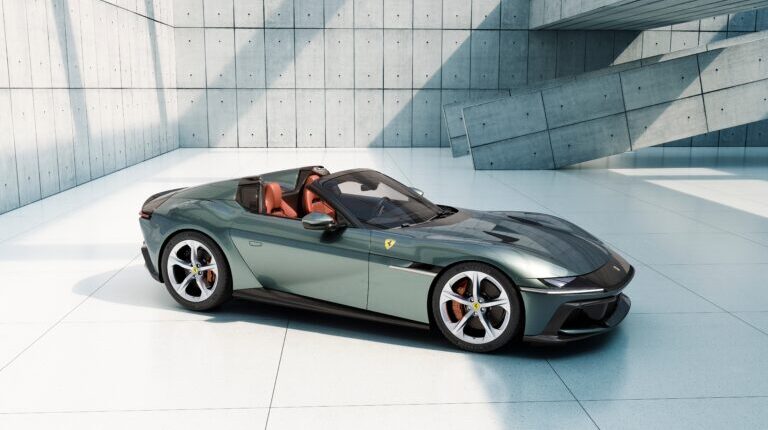On May 3, Ferrari introduced the 12Cilindri Spider, a two-seater spider featuring a mid-front-mounted, naturally aspirated V12 engine. According to the auto maker, this new model combines the allure of open-air motoring with the timeless appeal of Ferrari’s iconic V12 powertrain.
Inspired by the open-topped Ferrari Gran Turismo models from the 1950s and 1960s, the 12Cilindri Spider pays homage to the brand’s heritage while embodying modern design elements. It caters to enthusiasts who appreciate the characteristics of a V12 engine coupled with the thrill of driving with the top down.
At the heart of the 12Cilindri Spider lies the F140HD engine, a refined version of Ferrari’s V12 powerplant that delivers 830 cv and revs up to 9,500rpm. Ferrari says this engine promises a unique driving experience characterized by performance and sound.
The F140HD engine is the new version of the iconic naturally aspirated Ferrari V12, featuring modified components and software, some of which have already been adopted on the open-top special series 812 Competizione A.

Engineering enhancements focus on optimizing torque delivery and mechanical efficiency. Solutions such as titanium conrods and a redesigned valvetrain derived from Formula 1 technology contribute to the engine’s performance. Additionally, a novel software strategy adjusts torque output based on the selected gear, aiming to deliver smooth acceleration across the rev range.
For greater V12 revs, the engineers worked to reduce the weight and inertia of the engine’s components, adopting titanium conrods that Ferrari says guarantee a saving of 40% in rotating mass compared with steel with the same mechanical resistance. An aluminum alloy was used for the pistons, making them lighter than on previous applications. Further weight reduction was achieved by the adoption of a rebalanced crankshaft, which is reportedly 3% lighter.
The valvetrain with sliding finger followers was developed specifically for the V12 with the aim of reducing mass and achieving more high-performance valve lift profiles. The sliding finger follower, which is steel with a diamond-like carbon (DLC) coating, transmits the action of the cam to the valve using a hydraulic tappet as the pivot for its movement. The use of DLC aims to reduce the coefficient of friction at critical points to improve the mechanical efficiency of the engine.
Optimization of the engine’s mechanical efficiency was achieved using the calibration of the variable-displacement oil pump, which is designed to allow the oil to circulate throughout the entire engine and then be recovered along with the vapors from the sump. A solenoid valve, controlled by the engine ECU, is used to control the pump’s displacement in terms of engine revs and pressure, delivering only the amount of oil required and simultaneously saving energy.
What’s more, the gasoline direct injection system (GDI at 350 bar) comprises two petrol pumps and four rails with pressure sensors that provide feedback to the pressure control system. The electronic injectors can control up to three injections per engine cycle.
The ignition system is managed by an ION control unit that has a single-spark and multi-spark function. This unit also serves a knock monitoring and control function, using a strategy for recognizing the quality (octane rating) of the fuel in the tank to maximize the thermodynamic efficiency of the engine.

The new exhaust system, developed to allow the car to comply with the latest emissions requirements (EU6E, China 6b and Bin 50), introduces a ceramic catalytic converter coupled with a particulate filter. Ferrari says this is the most advanced emissions-reduction technology available; its development involved lengthy calibration of the software strategies.
The 12Cilindri Spider also features an advanced cooling system designed to meet the demands of the high-performance engine. Seven openings in the front bumper optimize airflow to key components, including the engine coolant radiator and brake system. The chassis, constructed from lightweight aluminum, achieves a 15% increase in torsional rigidity compared with previous models, according to Ferrari.
In terms of vehicle dynamics, the 12Cilindri Spider benefits from control systems, including brake-by-wire technology and the latest iteration of Ferrari’s Side Slip Control. These systems are designed to work in harmony to optimize performance and handling.



